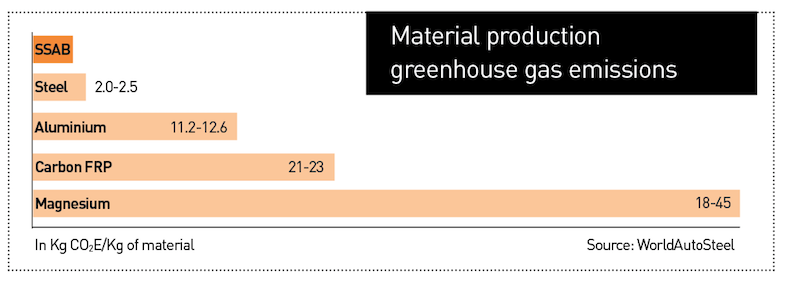
Advanced high-strength steel offers advantages for cost and sustainability in automotive manufacturing
 Looking into the future of automotive manufacturing, some challenges are clear. Vehicle weight, environmental impact and the number of injuries due to accidents must all be reduced, yet costs cannot be allowed to rise. Advanced high-strength steel (AHSS) is one material that can deliver the best of both worlds – lower cost as well as greater sustainability. On the Life Cycle Assessment (LCA) scale, AHSS lets OEMs have their cake and eat it too. A deeper look shows why.
Looking into the future of automotive manufacturing, some challenges are clear. Vehicle weight, environmental impact and the number of injuries due to accidents must all be reduced, yet costs cannot be allowed to rise. Advanced high-strength steel (AHSS) is one material that can deliver the best of both worlds – lower cost as well as greater sustainability. On the Life Cycle Assessment (LCA) scale, AHSS lets OEMs have their cake and eat it too. A deeper look shows why.
AHSS is an established material in the automotive industry, commonly used in selected structural body reinforcements, bumper reinforcements, door impact beams as well as seat frames and mechanisms. It is responsible for helping to achieve five-star crash ratings and reducing component weight by up to 40%. It also allows for the development of more innovative components that are more competitive on the market. What may not be known by all, however, is that its use can effectively cut costs throughout the production chain, while leading to many environmental advantages.
When looking at the environmental impact of materials in automotive manufacturing, most turn to the Life Cycle Assessment. The LCA takes into consideration all emissions that a material in a car produces, including the production of the material itself, and the total CO2 emissions during the lifetime of a vehicle. Steel has an advantage compared to some other lightweight materials, as it emits less CO2 when being produced. For car manufacturers, this translates to a strong argument for sustainability.
The sustainable edgeBy comparing the lightweight materials of steel, aluminium, carbon fibre-reinforced plastics and magnesium, it can be seen that steel has far lower greenhouse gas (GHG) emissions in the production phase. A look at the production of AHSS from the cleanest facilities, like the production of Docol AHSS from SSAB, shows even better numbers.

“Comparing steel, aluminium, CFRP and magnesium, it can be seen that steel has far lower GHG emissions in the production phase” - Arnaud Guerendel, SSAB
In addition to the advantage of low CO2 emissions in production, steel is also a 100% recyclable material. This is an important attribute as some regions of the world are beginning to demand that 95% of the materials used in a car should be recyclable.
“While other materials are considered 100% recyclable, steel provides the possibility to make a wide range of grades from recycled material. Other lightweight materials can only be repurposed for basic use after recycling. In this respect, steel is best-in-class once more. With the use of advanced high-strength steel, the challenges that come with complex multi-material solutions can be eased,” explains Arnaud Guerendel, global sales director at SSAB.
Cutting costsHowever, AHSS is not only the most sustainable choice for automotive manufacturers, it is also the most cost-effective. For example, when used for beams and reinforcements in cars, advanced high-strength steel makes it possible to obtain the same weight reduction as with aluminium, but at a much lower price.One prominent automotive OEM made a cost-per-kilogramme comparison of lightweight materials and found that the cost to reduce the weight of the car body by 1kg was dramatically lower with steel compared with that of aluminium, magnesium and CFRP.
 In addition, consistent properties that reduce scrap, downtime and issues in production also contribute greatly to the cost savings and are a big part of the value in using steel. “Many grades of advanced high-strength steel allow for cold forming. This means that trimming can be performed with conventional hard cutting tools instead of laser cutting, for example. This may require less energy than with other materials and allows for more productivity that can translate directly to cost savings,” explains Guerendel.
In addition, consistent properties that reduce scrap, downtime and issues in production also contribute greatly to the cost savings and are a big part of the value in using steel. “Many grades of advanced high-strength steel allow for cold forming. This means that trimming can be performed with conventional hard cutting tools instead of laser cutting, for example. This may require less energy than with other materials and allows for more productivity that can translate directly to cost savings,” explains Guerendel.
When using AHSS, it is also important to use steel from an experienced steel mill that has the capability to produce AHSS with consistent properties.The unique strength and technical properties of advanced high-strength steel allow OEMs to reduce the amount of material needed for manufacturing an application by utilising thinner dimensions. At the same time, conventional production equipment can be utilised.
“Advanced high- strength steel also allows for a much lower manufacturing cost at OEMs since steel components can be assembled by traditional means with little-to-no chemicals or additional processes, like glue and mechanical joining,” says Guerendel. “Steel is simply cheaper and easier to use and provides the best industrial capacity in terms of mass production.”
Guerendel goes further, explaining that there is a big advantage for steel in this comparison as well as differences between steel itself.
“SSAB has one of the cleanest steel manufacturing processes in the world and by using advanced or ultra-high strength steel you can further reduce the emissions as you will be using less steel.”
The role of SSAB SSAB is a pioneer and one of the first producers of AHSS, with over 30 years of experience. Since day one, the company has focused on the continual development of grades with higher strength and better formability – as well as minimising their impact on the environment.
“Our steel production processes are some of the cleanest in the world,” says Guerendel. “With pure ore from northern Sweden and some of the cleanest steelmaking technology, we produce the most CO2-efficient steel for lightweight solutions. We can help to make cars lighter, stronger, cleaner and greener. By 2050 we plan to have a completely fossil-free production.”

For producing Docol AHSS – SSAB’s steel for the automotive industry – two mills are mainly used. The SSAB mill in Borlänge, Sweden has a cold-rolling line with one of the world’s most advanced continuous annealing lines. I
n Hämeenlinna, Finland, SSAB operates a modern metal coating line for different types of coatings. Production lines for precisions tubes made from advanced high-strength steel can also be found there. Most ore comes from Swedish mines which are world famous for their properties and cleanliness, providing steels with robust and equivalent integrity.
“From a sustainability standpoint, SSAB is becoming a sort of leader in the industry. However, this is a normal part of what we do,” says Guerendel. “We are very proud of our work and all of the research we do internally. W
e are proud of the investments and our evolution of steel production from the carbon era. We have many ongoing initiatives that are focused on the environment and will continue this progression into the future.”
Real world proofSo where has the LCA of advanced high-strength steel been taken into account when developing automotive components? One good example is a new side impact beam for car doors using SSAB’s advanced ultra-high-strength steel, Docol 1200M. The beam was formerly produced from hot-stamped boron steel, but has now been changed to cold-formed AHSS in an effort to reduce costs.
By using AHSS, the OEM in question has eliminated the need to heat blanks in the hot stamping/press hardening process to 900°C before stamping. The beam can be produced and recycled with lower CO2 emissions compared to other lightweight materials and the same crash performance was reached.
The overall pictureAs governments set higher requirements on CO2 emissions, fuel economy and production, OEMs must find a way to manufacture their products in a cost-effective way. Smart designs with AHSS present an easier path ahead.
“We want suppliers and OEMs to have the best possible productivity when making parts for a car or supplying parts to a car manufacturer,” says Guerendel. “We guarantee consistent and high quality that will improve the cost savings per item. Having the cleanest steelmaking technology available will also help you meet the environmental targets for the automotive industry, which is an important value to consider.”www.ssab.com





































